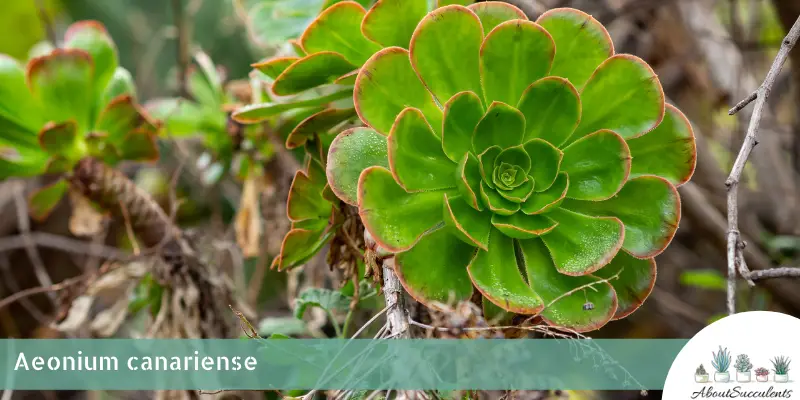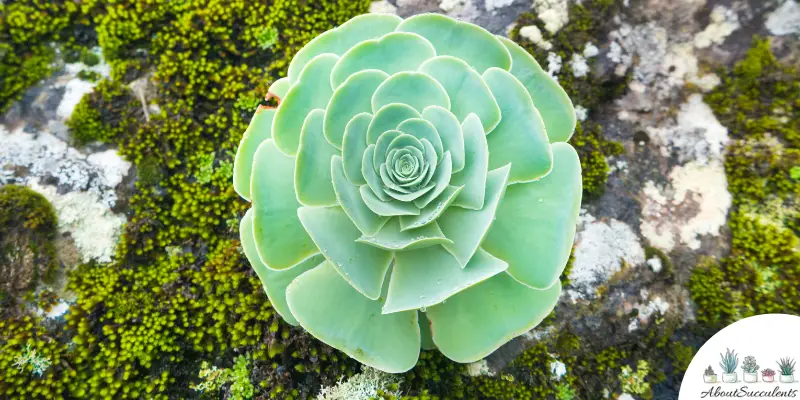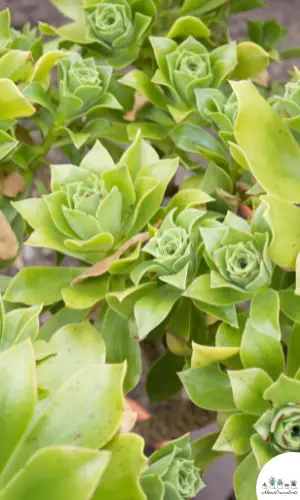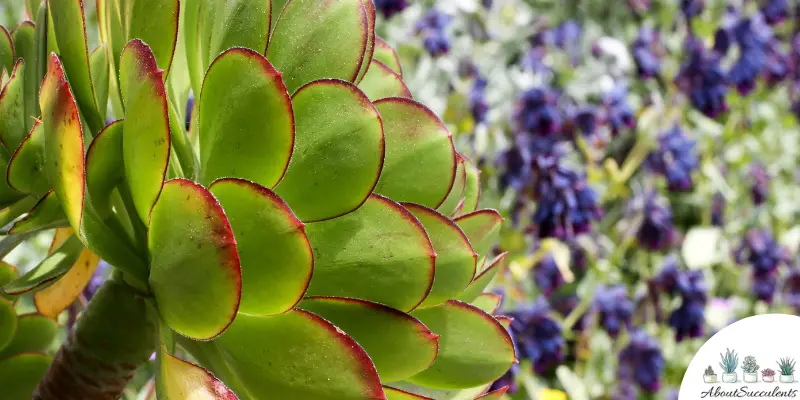
Aeonium canariense is an enchanting succulent that can illuminate your home or outdoor garden with its luminescent emerald green leaves which can assume a reddish-purple color when consistently exposed to sunlight.
Nurseries might sell this variegated, shrub-like perennial by its alias “Giant Velvet Rose”. Not only is the alias easier to pronounce and remember but it’s aptly descriptive of this large plant which can grow to a height of 1-foot (30cm).
The emerald green leaves are fleshy and have a fuzzy texture reminiscent of velvet and they grow into compact rosettes that can reach a width of 8-inches (20cm).
In the summertime, expect Giant Velvet Rose to produce small, star-shaped, yellow-colored flowers that sit on top of 3-foot (90cm) long stems. The flowers measure a quarter of an inch (0.64cm) wide.
Aeonium canariense is a monocarpic succulent and will die shortly after producing flowers. This type of succulent is native to Tenerife of the Canary Islands.
Giant Velvet Rose belongs to the genus Aeonium and is a member of the Crassulaceae family. Coincidentally, the name of the island of where it is endemic from is called Canary Island Aeonium.
General Information
Also known as: Giant Velvet Rose
Plant Family: Crassulaceae
Origin: Tenerife of the Canary Islands
Height: 1-foot (30cm)
Exposure: Partial to full sun exposure for up to 6 hours per day.
Water Needs: Drought-tolerant; only water the soil when you can confirm that it has dried out completely.
Soil Type: Sandy soil with loam plus 50% gritty materials such as coarse sand, pumice, perlite, and lava rock for better draining qualities.
Soil pH: 5.6 to 6.0
How to Grow and Care for Aeonium Canariense

You’ll be forgiven to assume that Aeonium canariense with its magnificent, compact, and symmetrical rosettes must be a challenge to grow. The truth is exactly the opposite.
Giant Velvet Rose is a wonderful type of succulent to grow and care for whether you have an experienced green thumb or someone who’s looking to start a new hobby.
The rules for properly growing and maintaining Aeonium are simple and easy to remember. We can summarize it in one sentence:
Give Giant Velvet Rose sunlight every day but water sparingly.
However, if you live in an area where the temperature can drop below 20° F (-6.7° C), it would be best to plant Aeonium canariense in a container that you can move indoors. Aeonium canariense is tolerant of drought but not frost.
Sunlight
You have to provide Aeonium canariense 6 hours of partial or full sunlight every day. Aside from helping the succulent to produce food, stressing out the plant with the sun’s rays will change the leaves’ colors from emerald green to reddish-purple.
Giant Velvet Rose is ideal for an outdoor succulent or rock garden. Just make sure that its daily dose of the sun’s rays comes from the morning sun. The afternoon sun will be too hot and will burn Aeonium’s beautiful leaves.
If you want to grow Giant Velvet Rose as a home ornament, place its pot near a window that regularly receives up to 6 hours of partial sunlight every day.
It’s important to get Aeonium regular sun exposure or the leaves might stretch out and wither because it has undergone etiolation.
Watering

Those thick, lush, and enticing green leaves have a purpose. They store water that allows Aeonium canariense to survive long periods of drought. For this reason, you shouldn’t worry if you forget to water this succulent for weeks.
In fact, to ensure the health and long life of your succulent plants, you should water them only sparingly.
If you overwater Giant Velvet Rose, the soil will stay moist longer than necessary. The soil will become a breeding ground for fungi and the roots will rot. Once the roots rupture, the fungi will have a way to get inside Aeonium and contaminate the entire plant.
The best approach to water Aeonium canariense is the “Soak and Dry” method.
First, test the soil’s dryness. Some horticulturists will use a Hygrometer to measure the level of moisture but you’ll be fine with a stick. Just insert the stick about an inch deep into the soil then pull it out. If the stick comes out dry, get ready for step two.
Second, give the soil a thorough soaking. Again, water the soil and not the plant directly. If you’re watering an indoor Giant Velvet Rose, it’s had its fill if water starts coming out of the drain hole.
Pot and Soil
Terracotta or unglazed ceramic pots are the best choices for Aeonium canariense because these materials support aeration and at the same time, enable moisture to escape from the soil faster than other types of containers.
Choose a pot that’s slightly wider than the base of the plant in order for the roots to grow without getting tangled. More space also means that air can freely pass between the roots which dry out the soil faster. Make sure the pot has a drain hole at the bottom to filter out excess water.
Giant Velvet Rose does well in sandy soil and varieties that contain a little bit of moisture such as those mixed with loam. To improve drainage, add gritty materials such as perlite, pumice, coarse sand, or lava rock.
How to Propagate Aeonium Canariense

If you want more Aeonium canariense for your outdoor garden, your living room, or to adorn your office, you can propagate the species using 3 methods: Leaves, Offsets, and Seeds.
Leaves Method
Step 1: Remove a healthy leaf from the stem by gently twisting and performing a smooth and slow pull. If a part of the leaf remains on the stem, you won’t be able to propagate successfully.
Step 2: Let the leaves dry and form calluses over a period of 2 to 4 days.
Step 3: Fill a new terracotta pot with fresh, well-draining soil. Place the leaves on top of the soil but space them evenly.
Step 4: Spray the soil with water to moisten it lightly. Place the pot near a window that gets 4 to 6 hours of sunlight every day.
Step 5: If you notice the roots taking hold, water the soil only when it has gone completely dry.
Offsets Method
Step 1: Gently pull out the offsets that are growing near the base of the plant. You can free them up by cutting around the area with a sterilized and sharpened knife.
Step 2: Allow the offsets to develop calluses. This might take 2 to 4 days.
Step 3: Once the calluses have formed, plant the offsets in well-draining soil.
Step 4: Lightly water the soil and place the pot near a window that gets up to 6 hours of sunlight.
Step 5: If the roots have formed, put off watering the soil until it has 100% dried out.
Seeds Method
Step 1: Soak the seeds overnight in order to soften their tough outer layer.
Step 2: Plant the seeds in well-draining, sandy soil. Add perlite to balance out the level of moisture in the soil. The best time to plant is when temperatures are warm.
Step 2: Lightly water the soil and place it under a Grow Light or a Seed Warmer. You should notice the seeds sprouting out in six weeks’ time. Water the soil only when it has dried out.
Frequently Asked Questions
Is Aeonium Canariense Toxic to Cats and Dogs?
Aeonium canariense doesn’t appear in the list of plants that are toxic to cats and dogs found on the website of the American Society for the Prevention of Cruelty to Animals (ASPCA).
Why Is My Aeonium Canariense Dying?
Aeonium canariense will survive dry weather and harsh conditions but it isn’t invulnerable to root rot caused by overwatering and fungal infection from pest infestation.
Overwatering
Telltale signs of overwatering are discoloration on the leaves and stems as well as mushiness. These are symptoms of an infection taking place inside the plant because the roots have rotted away and exposed your succulent to fungi.
To stop the spread of infection, cut off all of the infected sections with a sterilized knife or scissors. Then, remove the plant from the soil and cut off all of the roots that have gone rotten.
Allow Giant Velvet Rose 2 to 3 days to recover. Prepare a new pot for the succulent and fill it up with fresh succulent soil. Replant Aeonium canariense but don’t water the soil for 2 to 3 days.
Pest Infestation
Mealybugs, aphids, red spiders, and scale insects are attracted to the sap found inside the leaves of Aeonium canariense. Not only will they drain your plant of nutritious sap but these pests will leave white, waxy substances on the leaves that can lead to a fungal infection.
Wipe off the substances with a cotton ball soaked in 70% isopropyl alcohol and spray the plant with diluted neem oil to keep pests away.
Yes, Aeonium canariense produces flowers in the summertime. The flowers are small, star-shaped, and have a yellow color. Unfortunately, after Aeonium canariense blooms it will die.
Last Updated on June 9, 2022 by Sofia Lara